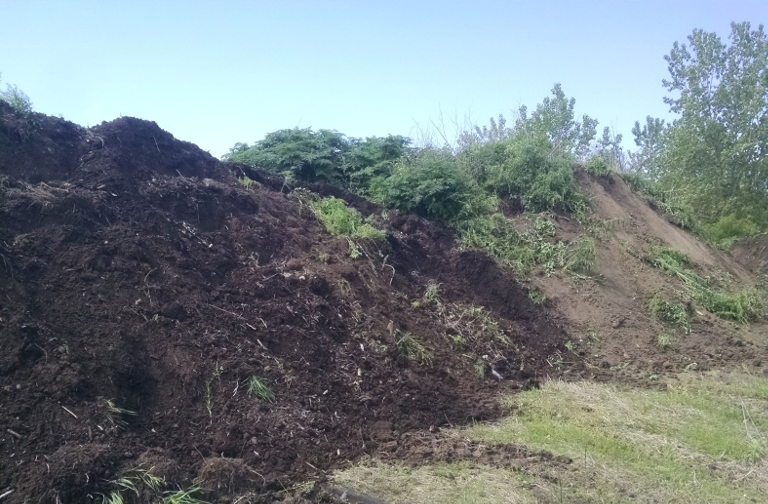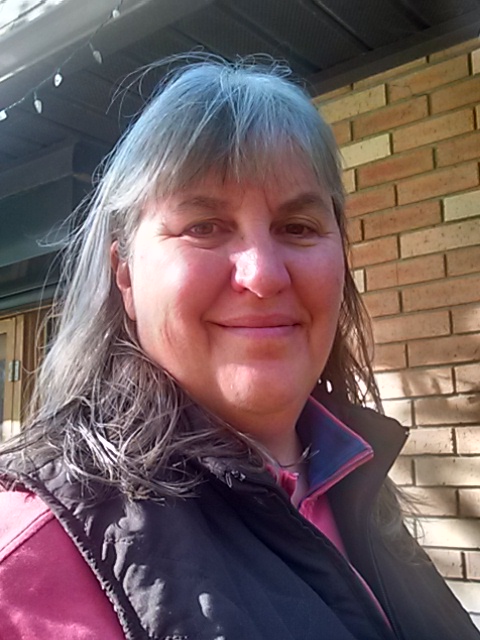
There are two ways of addressing rising concentrations of atmospheric carbon; reduce the amount of carbon emissions or increase the amount of carbon removed from the atmosphere. Most of our efforts have been focused on reducing emissions. I’d like to shift the conversation to drawing down atmospheric carbon dioxide.

The picture above was taken in the corn field near my home showing the hard and cracked soil in this field. The picture to the left was taken in my garden earlier this spring. I simply turned over a shovel of soil and you can see worms, roots, and soil structure all indicating a healthy soil. These pictures should make clear the differences between the degraded conventional farmland and healthy organic rich soil. My garden soil contains about 9% organic matter, which is refreshed each year with mulch used to suppress weeds and feed the soil. Most Midwestern farmland has been degraded and contains a small fraction of the organic matter it had when it was first farmed.
In our county we often see a decrease in organic matter from 5% to less than 1%. The soil in the farm field is little but dust particles. The surface cracks are an indication of what happens when the soil loses organic matter. It dries out and the surface hardens. This farm soil has no soil structure because it has lost it’s thriving microbial life, the bottom of the food chain. Without worms and fungi there is nothing working to form and hold opens pores, the soil surface becomes a hardened crusted surface soon after plowing and planting.
We can see debris on the surface from last year’s corn stalks indicating that this farmer planted corn for at least two consecutive years, something I see more frequently all the time. Corn is a ‘heavy feeder’ and planting it repeatedly is very bad for soil. Once the soil has become this degraded it is difficult to get a crop to grow without fertilizer and chemicals. These corn plants survive because they have been genetically engineered to survive massive chemical inputs. But even with genetic engineering these plants still need water and when soil is hard and cracked rain will run off the field as opposed to soaking into the soil.
Plants pull carbon from the atmosphere and microbes convert plant debris into soil carbon. It’s much more complicated than that simple definition but essentially that is what nature does. In order to draw down carbon from the atmosphere we simply need to manage farmland, forest, and prairies in ways that enhance plant growth and carbon fixation in the soil. To do this we need to change agriculture. On a small scale in my backyard garden I can add carbon in the form of compost and mulch easily. On a large scale across millions of acres it will require much more work with regenerative farming practices that restore the “soil carbon sponge”. If you want to learn more I highly recommend watching this fascinating video by Walter Jehne, who clearly lays out the potential benefits from sequestering carbon in soil.
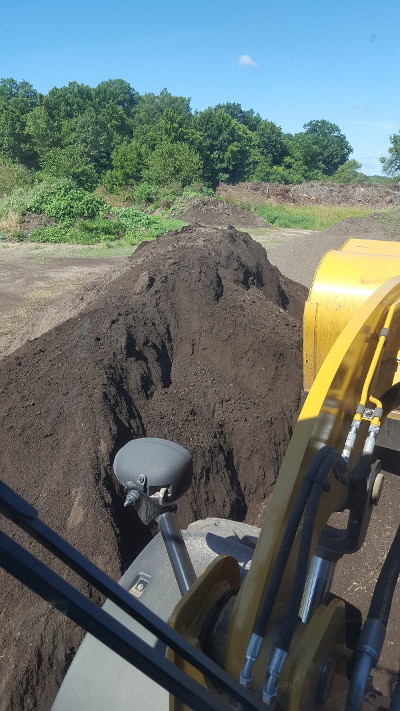
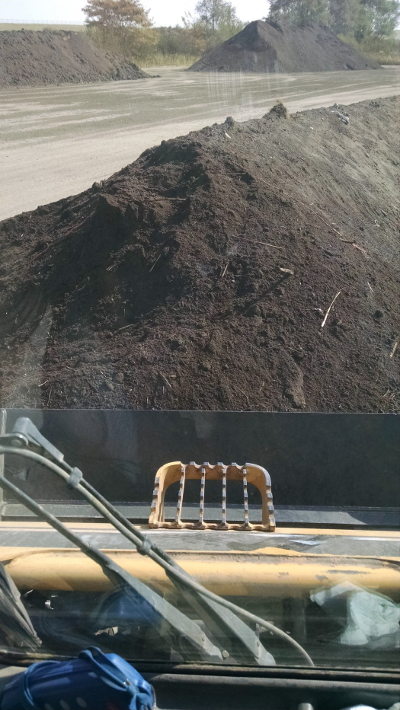
I understand the value of increasing organic matter in soil. In part because I studied soil science but also because for 20 years I have owned and operated a composting/soil making business called “Soilmaker”. I process hundreds of tons of organic wastes from our community each year turning it into soil, compost, and mulch. “Soilmaker….we make soil better!” The carbon cycle is straight forward. Every living organism is part of the soil making cycle. It is relatively easy to biodegrade organic wastes and use them to convert depleted topsoil into organic rich, healthy soil. I buy natural soil similar to the depleted farm soil pictured above and turn it into healthy rich soil by adding compost and mulch. The pile in the picture below was once a depleted soil and by simply adding decomposed, mulched green waste I have increased organic matter and improved the quality of this soil significantly.
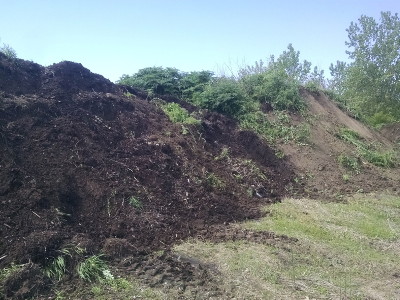
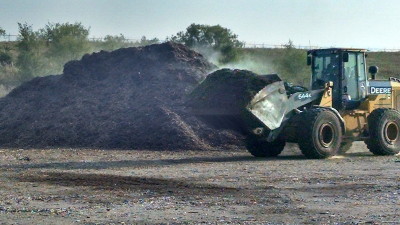
Every Midwestern municipality generates a large volume of tree trimmings, leaves, grass clippings, and biomass from waste water treatment. I process a fraction of the organic wastes in my community selling products to thousands of customers, many of whom have established back yard vegetable gardens such as my own. But rarely do I sell to conventional farmers, who manage thousands of acres and plant almost exclusively corn and soybeans. It would be cost prohibitive for them to amend thousands of acres with even small amounts of compost or mulch.
Most conventional farmers cannot afford to amend their soil, nor can they afford to change their farm practices. They are trapped in debt with little control over a system that forces them to over produce driving prices so low few of them can get out of debt. Some turned to confined animal feeding operations and now are trapped in contracts that strip away the profit and control, while putting most of the risk on the farmer. Farmers that grow crops are trapped in this system by the debt they owe for buildings, machinery, seeds, and chemicals. Their soil is so depleted they are dependent on the chemicals and GMO seeds in order to grow any crop. No farmers have control over the market that buys their products. The market for farm and food products has been vertically integrated by agricultural monopolies.
The margin of profit on an acre of conventional farm land is slim. Most large farms own part of their land and rent the rest. In order to plant and harvest several thousand acres of cropland a farmer must buy hundreds of thousands of dollars in farm equipment, and borrow several million dollars to buy seeds and chemicals each spring. Input costs are high and changing anything, such as applying a cover crop or amending the soil will often mean the farmer loses money. The profit in agriculture and food production goes to the seed and chemical companies who sell inputs to the farmers, and to the food processing companies that sell manufactured food products to us. Vertical integration and business consolidation has dramatically shifted US agriculture. Most small and midsize farmers depend on off farm income to actually support their family. Mega-sized farms depend on government subsidies. Change is coming but too slow for most American farmers to survive weather events such as this spring’s flooding.
Even though it is clear that conventional farming practices are not sustainable and that manufactured food is not healthy for people or the environment, it is not clear how to transform this system. We are fighting against debt, entrenched corporate interests, and bad government policies. We are looking at an enormous project to improve farmland and sequester carbon in the soil! But many people have ideas on how we might accomplish this transformation.
We start by reducing the amount of corn and soybeans planted, which mainly go into processed food products, ethanol, and confined animal feeding. We can pay farmers to set aside land for fast growing weeds and shrubs. Cover crops are an important part of managing farm fields but weedy shrubs have a higher concentrations of lignin and cellulose that will stay in the soil longer and create a larger volume of humus. Weeds also have the added benefit that they don’t require planting because their seeds are already in the soil. Weedy plants also thrive on degraded soil. This type of plant can draw more carbon from the atmosphere very quickly and feeds soil fungi. There only cost to the land owner is the expense of periodically chopping, shredding and incorporating the debris into the soil.
We also need microbes and fungi. We need to help farmers make compost on the farm. We need to put herbivores back together with cropland, particularly ruminants. See Jehne’s discussion on how grasslands and ruminants evolved together and the potential for oxidizing methane. Goats are wonderful because they actually thrive on low quality forage. They prefer shrubby plants and weeds. I used to stake my goat near my strawberry patch because she preferred the thistle over the strawberry plants. A farmer could also pasture pigs and chickens together because they naturally root, dig, and scratch in soil incorporating organic matter without requiring machines and diesel fuel. Livestock will require putting back fencing on farms. Government programs could help farmers with the cost of managing the land while it is being rejuvenated.
Improving soil carbon storage takes many years but if we apply these principles across as much land as possible over the next decade we will be drawing down atmospheric carbon allowing us more time to also get off fossil energy and reduce carbon emissions. Support for putting a price on carbon emissions is growing and we could transfer some of this money to help farmers increase soil organic matter based on calculations of verifiable increases in soil organic matter. We can change our diets and help farmers transition to growing more local diversified crops such as small grains and legumes, vegetables and fruit, hay, and pasture raised meat and dairy. Government policies could be improved to help facilitate direct sales to customers allowing farmers to once again have some control over the local market. Small rural communities could once again thrive from local businesses and markets. But in order for this to happen we need to change our diets, eating more plant based foods and less meat and dairy, and buying from local farmers.
If we increase the growth of lignin-rich plants, sequester their carbon in the soil, and change our dietary habits we have a chance of greatly reducing carbon dioxide in the atmosphere, improving soil health, capturing rainwater, improving water filtration and cooling the landscape. This the best way of geoengineering the draw down of atmospheric carbon. We are simply using natural processes that have evolved over hundreds of millions of years. We would put back the carbon that has been lost from the soil over many decades of poor management, cooling the earth, and reducing the impact of climate change. Reducing emissions of carbon is only one side of the solution. We need to approach solutions from both sides of the equation.


